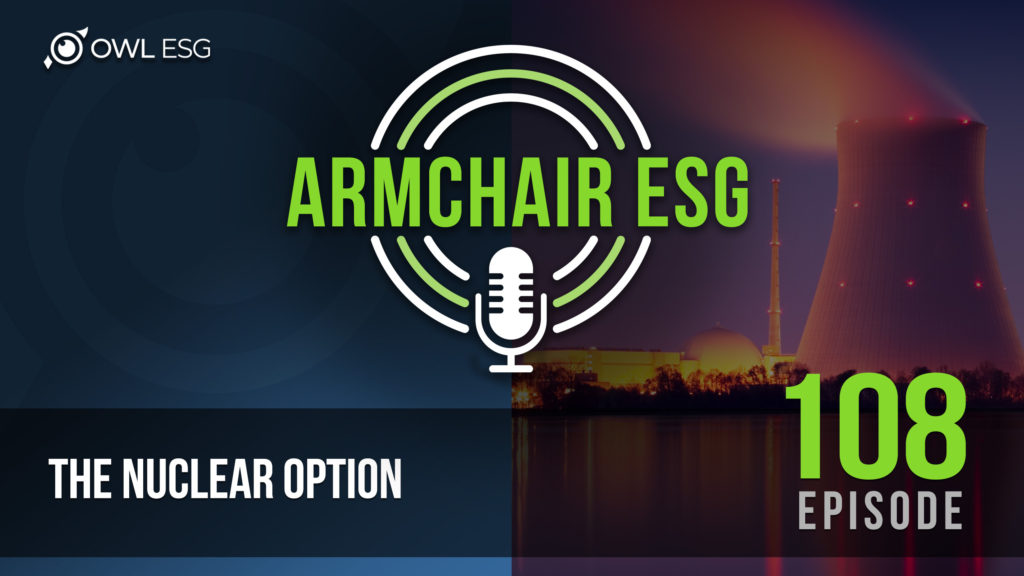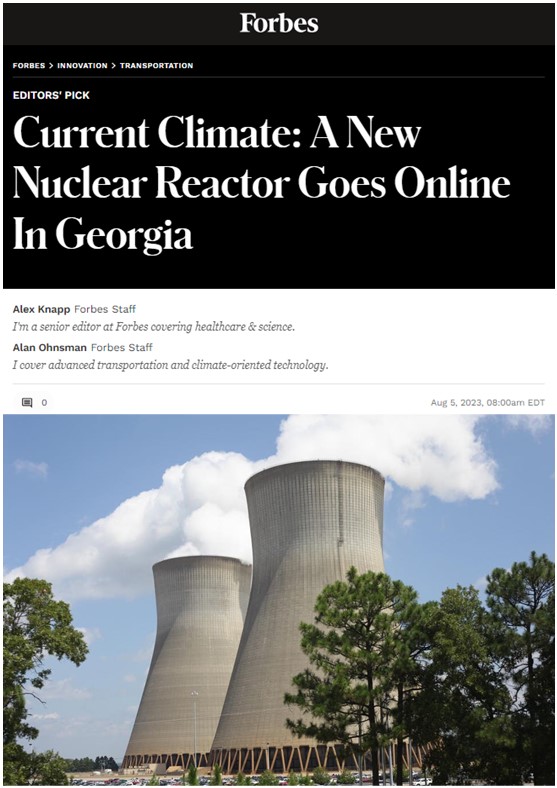Almost all energy on Planet Earth is ultimately nuclear. The sun is a giant fusion reactor, and fossil fuels release solar energy stored in the carbon of massive old growth forests from millions of years ago. Wind energy is driven by temperature changes spurred by energy from our sun, and solar energy is, of course, direct energy from the sun. Despite the incredible promise of nuclear energy to deliver consistent power that’s nearly carbon-free, misconceptions and highly visible public accidents have caused humanity to shift away from nuclear energy as a clean, reliable power source .
On Monday, July 31, Georgia Power’s Vogtle Unit 3 nuclear reactor came online. It is the first reactor to come online in more than seven years, and the first built from the ground up in more than 30 years. In perhaps the most perfect example of the contrast of nuclear power’s extraordinary promise and its fearsome destructive power when uncontrolled, August 6 and 9 mark the 78th anniversary of the United States dropping nuclear bombs on Hiroshima and Nagasaki at the end of World War II.
As the world struggles with the contradicting needs to increase energy production in a way that keeps up with a rapidly growing population against efforts to significantly reduce annual carbon emissions, of which energy production is a massive source, nuclear energy presents a seemingly perfect solution. Nuclear fission, and eventually fusion, are nearly carbon-free means of energy production that are also reliable, able to deliver huge power loads with no change in output when the weather doesn’t cooperate.
The new Georgia reactor alone is expected to generate up to 1,100 megawatts of power, providing consistent electricity to around 500,000 homes. It was not without setbacks though, as the reactor, originally expected to go online in 2016, was seven years late and an astonishing $17 billion over budget. Because of this, once-high expectations for a resurgence of nuclear energy on the United States have rapidly diminished.
The U.S. gets roughly 20 percent of its total power generation from 93 nuclear plants, the highest proportion in the world. At one time, this number was expected to be much higher, as nuclear plants were springing up relatively quickly in not just the U.S., but around the world as well, and the promise of nuclear energy even created a bridge between the U.S. and the USSR.
However, waves of historical interest in increasing investment and development around nuclear energy have run into public backlash, driven by high-profile and sensational nuclear disasters. Oliver Stone’s recent documentary, Nuclear Now, highlights how the constant coverage of the Chernobyl and Three-Mile Island spurred vociferous activism that completely stopped the ambitious plans to grow the nuclear energy sector. A more recent resurgence in interest in nuclear power in 2008, which was the genesis of the Vogtle Unit 3 (and the Unit 4, expected to come online later this year), similarly waned following the events of the Fukushima reactor.
Without question, unleashed at its full capacity, nuclear power has unparalleled destructive capabilities. It is the same characteristics that make it such a reliable and efficient source of energy that can also level cities and render massive swaths of land uninhabitable from radioactivity. But the technology to keep our lights on and the technology to make bombs are not as directly linked as popular culture advertises.
Nuclear bombs require highly refined elements like plutonium, and are designed to trigger uncontrolled and self-sustaining reactions, unleashing the full power of the splitting or fusing atoms. Nuclear reactors, in contrast, are designed specifically to generate controlled reactions at a certain level, with numerous redundancies and fail-safes built on top of extensive safety protocols. Chernobyl, by far the worst nuclear plant meltdown in history, was the result of callous disregard for these fail-safes, among a host of other safety rules that were ignored and warning signs that the Soviet government disregarded. Three Mile Island and Fukushima were contained disasters because safety features ended up working as intended.
Beyond the explosion of a meltdown, radiation is a common word raised as a scare tactic to drive anti-nuclear sentiment. But radiation exists everywhere, and our livelihood depends on it. The sun bathes the planet in constant radiation; your microwave, cell phone, remotes, and most all other technology rely on radiation to function; our modern society could not operate without radiation, and our bodies are good at absorbing small amounts of radiation. Obviously, intense radiation from fissile materials can kill people quickly or lead to several health concerns, but, again, modern safety procedures are effective in preventing radioactive materials from entering the environment.
Sensationalism around meltdowns and radiation aren’t the only misconceptions about nuclear power generation. More people die every year as a result of accidents with oil and coal power generation than have died in all of history from nuclear accidents, but the media hype remains focused on the headline grabbing, historically rare, nuclear accidents. It’s similar to air travel versus car travel. Statistically, flying is far safer, but plane crashes get headlines, and the emotional response is something the media seeks.
One thing nuclear power does give is carbon-free energy that is not subject to changes in the weather. The heat generated by controlled nuclear reactions turns water into steam that powers turbines, generating electricity. There are no emissions, and the power generation continues when there is no wind or sun. Grid capacity is maintained and brownouts are not a problem.
Nuclear power generation does create spent fuel, which is highly radioactive. However, the totality of spent fuel generated in the United States history could be contained in an area the size of a football field, dug 30 feet deep. We are good at storing this fuel safely, with no fear of radioactivity leaking out into the broader world. Further, evolving technology makes it increasingly easy to safely and efficiently recycle the spent fuel and use it in the reactors again, reducing cost and environmental impact.
Technological advances are driving other promising developments in the nuclear power generation industry. Scientists have successfully created self-sustaining nuclear fusion reactions on multiple occasions. While this technology is likely a few decades away from commercial application, it promises clean power generation at massive scales with no concerns about radioactive byproducts.
And new, small modular reactors have recently been approved in the U.S. by the Nuclear Regulatory Commission. These use fission technology, but at much smaller capacities, and can be placed in individual buildings or used for specific purposes, or they can be grouped together for larger energy needs. Ultimately, the world’s energy requirements are only going to continue going up, and likely at an accelerating pace, especially as more developed markets modernize and their industry demands large amounts of power. To meet these energy requirements in a sustainable manner, but also without concerns about leaving people in the cold, literally, an objective look at the benefits of nuclear power seems the only prudent way forward.
Contact us to learn about our in-depth data, extensive coverage and custom solutions, and why so many organizations choose OWL to meet their needs for ESG data and analyses.

The Armchair ESG with Nate and Yates delve deeper into the subject of nuclear power.
Click on the link to listen/watch our podcast.





